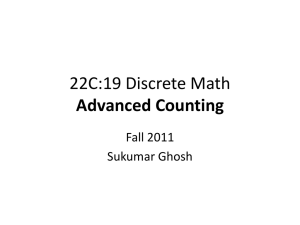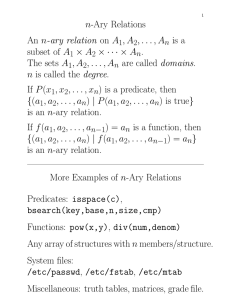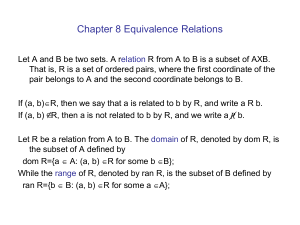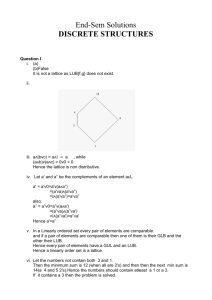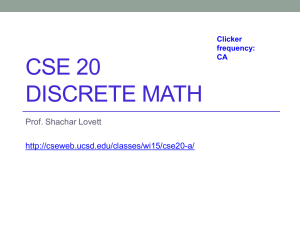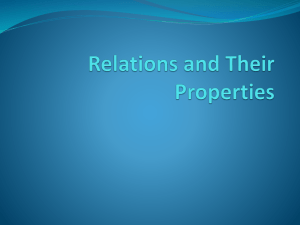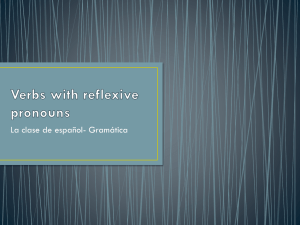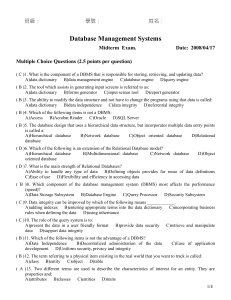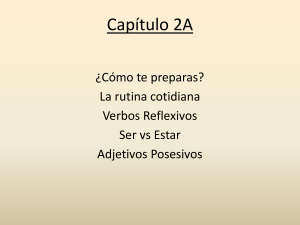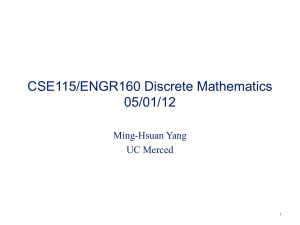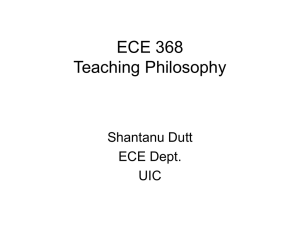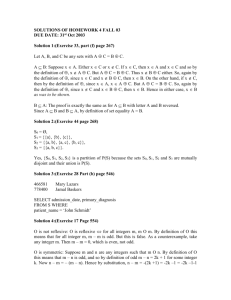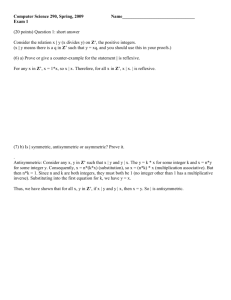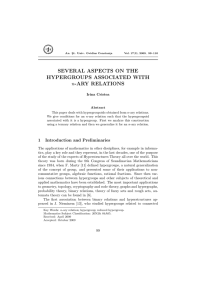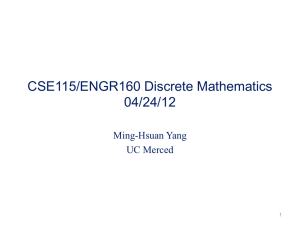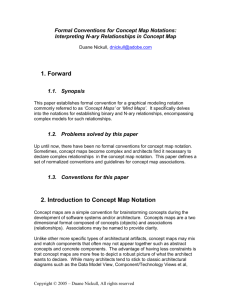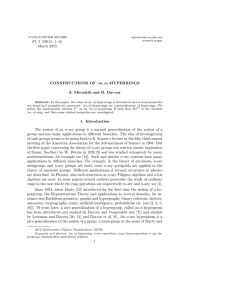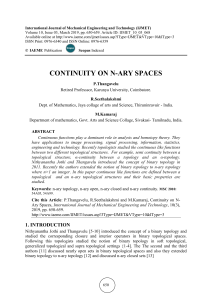Relations
advertisement
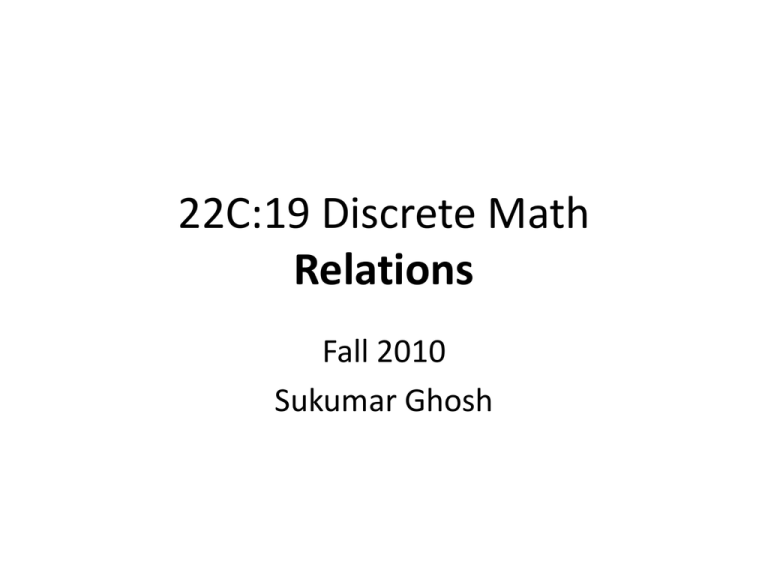
22C:19 Discrete Math
Relations
Fall 2010
Sukumar Ghosh
What is a relation?
What is a relation?
Representing Relations
Relations vs. Functions
When to use which?
Relation within a set
Properties of Relations
We study six properties of relations:
What are these?
Reflexivity
Example.
= is reflexive, since a = a
≤ is reflexive, since a ≤ a
< is not reflexive is a < a is false.
Symmetry
Anti-symmetry
More on symmetric relations
Transitivity
Examples of transitive relations
Summary of properties
=
Reflexive
>
X
Irreflexive
Symmetric
<
X
X
X
X
≤
≥
X
X
X
X
X
X
X
Asymmetric
Antisymmetric
X
Transitive
X
X
X
Operations on relations
Let A = {1, 2, 3} and B = (1, 2, 3, 4}. Define two relations
R1 = {(1,1), (1,2), (1,3)}
R2 = {(1,1), (1,3), (1,4)}
Then,
R1 ⋃ R2 = {(1,1), (1,2), (1,3), (1,4)}
R1 ⋂ R2 = {(1,1), (1,3)}
R1 - R2 = {(1,2)}
More operations on relations:
Composition
Let S be a relation from the set A to the set B, and R be
and R be a relation from the set B to the set C. Then, the
composition of S and R, denoted by S ◦ R is
{(a, c) | a ∈ A, b ∈ B, c ∈ C such that (a, b) ∈ S and (b, c) ∈ R}
EXAMPLE. Let A = {1, 2, 3}, B = { 1, 2, 3, 4}, C = {0, 1, 2}
S = {(1,1), (1,4), (2,3), (3, 1), (3, 4)}
R = {(1,0), (2,0), (3,1), (3, 2), (4,1)
Then S ◦ R = {(1,0), (1,1), (2,1), (2,2), (3,0), (3,1)
More operations on relations:
Composition
Rn = Rn-1 ◦ R = R ◦ R ◦ R ◦ R … (n times)
EXAMPLE. Let R = {(1,1), (2,1), (3,2), (4,3)},. Then
R2 = R ◦ R = {(1,1), (2,1), (3, 1), (4,2)}
R3 = R2 ◦ R = {(1,1), (2,1), (3, 1), (4,1)}
R4 = R3 ◦ R = {(1,1), (2,1), (3, 1), (4,1)}
Notice that in this case for all n > 3, Rn = R3
n-ary relations
Has important applications in computer databases.
DEFINITION. Let A1, A2, A3, …, An be n sets. An n-ary relation
is a subset of A1 x A2 x A3 x… x An
EXAMPLE. R is a relation on N x N x N consisting of triples
(a, b, c) where a < b < c. Thus (1, 2, 3) ∈ R but (3, 6, 2) ∉ R
Relational Data Model
Student Record
Name
ID
Major
GPA
Alice
211 324
Physics
3.67
Bob
123 456
ECE
3.67
Carol
351 624
ECE
3.75
David
000 888
Computer Science
3.25
The above table can be viewed as a 4-ary relation consisting of the 4-tuples
(Alice, 211324, Physics, 3.67)
(Bob, 123456, ECE, 3.67)
(Carol, 351624, ECE, 3.75)
(David, 000888, Computer Science, 3.25)
Relational Data Model
Name
ID
Major
GPA
Alice
211 324
Physics
3.67
Bob
123 456
ECE
3.67
Carol
351 624
ECE
3.75
David
000 888
Computer Science
3.25
A domain is called a primary key when no two n-tuples
in the relation have the same value from this domain.
(These are marked red).
Operations on n-ary relations
SELECTION
Let R be an n-ary relation, and C be a condition that the
elements in R must satisfy. Then the selection operator
SC maps the n-ary relation R to the n-ary relations from R
that satisfy the condition C.
Essentially it helps filter out tuples that satisfy the desired
properties. For example, you may filter out the tuples for all
students in ECE, or all students whose GPA exceeds 3.5.
Operations on n-ary relations
PROJECTION
The projection Pi,j,k,…,m maps each n-tuple (a1, a2, a3, …, an)
to the tuple (ai, aj, ak, …, am).
Essentially it helps you delete some of the components of each n-tuple.
Thus, in the table shown earlier, the projection P1,4 will retain only that
part of the table that contains the student names and their GPAs.
Use of the operations on
n-ary relations
SQL queries
SQL queries carry out the operations described earlier:
SELECT GPA
FROM Student Records
WHERE Department = Computer Science
Representing Relations Using Matrices
A relation between finite sets can be represented using a 0-1 matrix.
Let A = {a1, a2, a3} and B = {b1, b2, b3}. A relation R from A to B can be
represented by a matrix MR, where mij = 1 if (ai, bj) ∈ R, otherwise mij = 0
b1
b2
b3
a1
0
0
0
a2
1
0
0
a3
1
1
0
The above denotes a relation R from A = {1,2,3} to B = {1,2,4}, where for each element
(a, b) of R, a > b
Representing Relations Using Matrices
A reflexive relation on a given set A is recognized by a 1 along the diagonal
1
0
1
0
0
1
1
1
1
A reflexive relation
0
1
1
0
A symmetric relation
Representing Relations Using Digraph
A relation on a given set A can also be represented by a directed graph
1
2
3
1
2
3
1
0
0
1
1
0
1
1
Let A = {1, 2, 3}
1
2
1
3
A directed graph representation
of the relation shown on the left
Equivalence Relations
An equivalence relation on a set S is a relation that is
reflexive, symmetric and transitive.
Examples are:
(1) Congruence relation R = {(a,b) | a = b (mod m)}
(2) R = {(a, b) | L(a) = L(b)} in a set of strings of
English characters}, L(a) denotes the length of English
character string “a”
Partial Orders
A relation R on a set S is a partial order if it is reflexive,
anti-symmetric and transitive. The set is called a partially
ordered set, or a poset.
Examples are
(1) the ≥ relation,
(2) “x divides y” on the set of positive integers
(3) The relation ⊆ on the power set of a set S
Partial Orders
The relation ⊆ on the power set of a set S forms a partially ordered set
Source: http://en.wikipedia.org/wiki/Partially_ordered_set
